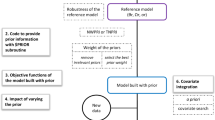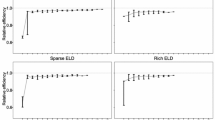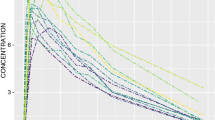The population approach to estimating mixed effects model parameters of interest in pharmacokinetic (PK) studies has been demonstrated to be an effective method in quantifying relevant population drug properties. The information available for each individual is usually sparse. As such, care should be taken to ensure that the information gained from each population experiment is as efficient as possible by designing the experiment optimally, according to some criterion. The classic approach to this problem is to design “good” sampling schedules, usually addressed by the D-optimality criterion. This method has the drawback of requiring exact advanced knowledge (expected values) of the parameters of interest. Often, this information is not available. Additionally, if such prior knowledge about the parameters is misspecified, this approach yields designs that may not be robust for parameter estimation. In order to incorporate uncertainty in the prior parameter specification, a number of criteria have been suggested. We focus on ED-optimality. This criterion leads to a difficult numerical problem, which is made tractable here by a novel approximation of the expectation integral usually solved by stochastic integration techniques. We present two case studies as evidence of the robustness of ED-optimal designs in the face of misspecified prior information. Estimates from replicate simulated population data show that such misspecified ED-optimal designs recover parameter estimates that are better than similarly misspecified D-optimal designs, and approach estimates gained from D-optimal designs where the parameters are correctly specified.
Similar content being viewed by others
References
Center for Drug Evaluation and Research (CDER). Guidance for Industry: Population Pharmacokinetics (1999).
N. H. Holford H. C. Kimko J. P. Monteleone C. C. Peck (2000) ArticleTitleSimulation of clinical trials Annu. Rev. Pharmacol. Toxicol. 40 209–234 Occurrence Handle10.1146/annurev.pharmtox.40.1.209 Occurrence Handle10836134
D. Z. D’Argenio (1981) ArticleTitleOptimal sampling times for pharmacokinetic experiments J. Pharmacokinet. Biopharm. 9 739–756 Occurrence Handle10.1007/BF01070904 Occurrence Handle7341758
A. C. Hooker M. Foracchia M. G. Dodds P. Vicini (2003) ArticleTitleAn evaluation of population D-optimal designs via pharmacokinetic simulations Ann. Biomed. Eng. 31 98–111 Occurrence Handle10.1114/1.1533074 Occurrence Handle12572660
S. B. Duffull S. Retout F. Mentré (2002) ArticleTitleThe use of simulated annealing for finding optimal population designs Comp. Meth. Prog. Biomed. 69 25–35 Occurrence Handle10.1016/S0169-2607(01)00178-X
S. B. Duffull F. Mentré L. Aaron (2001) ArticleTitleOptimal design of a population pharmacokinetic experiment for ivabradine Pharm. Res. 18 IssueID1 83–89 Occurrence Handle10.1023/A:1011035028755 Occurrence Handle11336357
M. Tod J.-M. Rocchisani (1996) ArticleTitleImplementation of OSPOP, an algorithm for the estimation of optimal sampling times in pharmacokinetics by the ED, EID and API criteria Comp. Meth. Prog. Biomed. 50 13–22 Occurrence Handle10.1016/0169-2607(96)01721-X
S. Retout S. Duffull F. Metre (2001) ArticleTitleDevelopment and implementation of the population Fisher information matrix for the evaluation of population pharmacokinetic designs Comp. Method. Prog. Biomed. 65 141–151 Occurrence Handle10.1016/S0169-2607(00)00117-6
M. Foracchia A. Hooker P. Vicini A. Ruggeri (2004) ArticleTitlePOPED, a software for optimal experiment design in population kinetics Comput. Method. Prog. Biomed 74 IssueID1 29–46 Occurrence Handle10.1016/S0169-2607(03)00073-7
R. J. Larsen M. L. Marx (1986) An Introduction to Mathematical Statistics and its Application EditionNumber2 Prentice-Hall Englewood Cliffs, NJ
R. R. Sitter (1992) ArticleTitleRobust designs for binary data Biometrics 48 1145–1155
E. M. Landaw (1985) Robust sampling designs for compartmental models under large prior eigenvalue uncertainties J. Eisendfeld C. Lisi ParticleDe (Eds) Mathematics and Computers in Biomedical Applications Elsevier Science North Holland 181–187
L. Pronzato E. Walter (1985) ArticleTitleRobust experiment design via stochastic approximation Math. Biosci. 75 103–120 Occurrence Handle10.1016/0025-5564(85)90068-9
M. Tod J.-M. Rocchisani (1997) ArticleTitleComparison of ED, EID and API criteria for the robust optimization of sampling times in pharmacokinetics J. Pharmacokin. Biopharm. 25 515–537 Occurrence Handle10.1023/A:1025701327672
F. Mentré C. Dubruc J. P. Thenot (2001) ArticleTitlePopulation pharmacokinetic analysis and optimization of the experimental design for mizolastine solution in children J. Pharmacokinet. Pharmacodyn. 28 IssueID3 299–319 Occurrence Handle10.1023/A:1011583210549 Occurrence Handle11468942
V. V. Fedorov (1972) Theory of Optimal Experiments Academic Press New York, NY
N. Laird N. Lange D. Stram (1987) ArticleTitleMaximum likelihood computations with repeated measures: application of the EM algorithm J. Am. Stat. Assoc. 82 97–105
M. Davidian D. M. Giltinan (1995) Nonlinear Models for Repeated Measurement Data Chapman and Hall New York
Y. Merle F. Mentré (1995) ArticleTitleBayesian design criteria: Computation, comparison, and application to a pharmacokinetic and a pharmacodynamic model J. Pharmacokinet. Biopharm. 1 101–125
E. F. Vonesh V. M. Chinchilli (1997) Linear and Nonlinear Models for the Analysis of Repeated Measurements Marcel Dekker New York
V. V. Fedorov P. Hackl (1997) Model Oriented Design of Experiments Springer New York
S. L. Beal and L. B. Sheiner. NONMEM user’s guide. Technical report, University of California, San Francisco (1992).
C. C. Peck S. L. Beal L. B. Sheiner A. I. Nichols (1984) ArticleTitleExtended least squares nonlinear regression: A possible solution to the “choice of weights” problem in analysis of individual pharmacokinetic parameters J. Pharmacokin. Biopharm. 5 545–557 Occurrence Handle10.1007/BF01060132
F. Mentré A. Mallet D. Baccar (1997) ArticleTitleOptimal design in random-effects regression models Biometrika 84 429–442 Occurrence Handle10.1093/biomet/84.2.429
B. M. Bell (2001) ArticleTitleApproximating the marginal likelihood estimate for models with random parameters Appl. Math. Comput. 119 57–75 Occurrence Handle10.1016/S0096-3003(99)00230-1
Y. Merlé M. Tod (2001) ArticleTitleImpact of pharmacokinetic-pharmacodynamic model linerization on the accuracy of population information matrix and optimal designs JPKPD 28 IssueID4 363–387
G. E. P. Box H. L. Lucas (1959) ArticleTitleDesign of experiments in nonlinear situations Biometrika 46 77–90
M. Tod F. Mentré Y. Merle A. Mallet (1998) ArticleTitleRobust optimal design for the estimation of hyperparameters in population pharmacokinetics J. Pharmacokinet. Biopharm. 26 IssueID6 689–716 Occurrence Handle10.1023/A:1020703007613 Occurrence Handle10485081
B. P. Carlin T. A. Louis (2000) Bayes and Empirical Bayes Methods for Data Analysis Chapman & Hall/CRC New York
P. S. Laplace (1986) ArticleTitleMemoir on the probability of the causes of events (English translation of the 1774 French original by Stigler SM) Stat. Sci 1 364–378
L. Tierney J. B. Kadane (1986) ArticleTitleAccurate approximations for posterior moments and marginal densities J. Am. Stat. Assoc. 81 IssueID393 82–86
E. F. Vonesh. A note on the use of Laplace’s approximation for nonlinear mixed-effects models. Biometrika :447–452 (1996).
A. Chait D. Foster D. G. Miller E. L. Bierman (1981) ArticleTitleAcceleration of low-density lipoprotein catabolism in man by total parenteral nutrition Proc. Soc. Exp. Biol. Med. 168 IssueID1 97–104 Occurrence Handle6798574
E. M. Landaw (1985) Optimal design for individual parameter estimation in pharmacokinetics Raven Press New York
D. Z. D Argenio (1990) ArticleTitleIncorporating prior parameter uncertainty in the design of sampling schedules for pharmacokinetic parameter estimation experiments Math. Biosci 99 IssueID1 105–118 Occurrence Handle10.1016/0025-5564(90)90141-K Occurrence Handle2134510
Author information
Authors and Affiliations
Corresponding author
Rights and permissions
About this article
Cite this article
Dodds, M.G., Hooker, A.C. & Vicini, P. Robust Population Pharmacokinetic Experiment Design. J Pharmacokinet Pharmacodyn 32, 33–64 (2005). https://doi.org/10.1007/s10928-005-2102-z
Received:
Accepted:
Issue Date:
DOI: https://doi.org/10.1007/s10928-005-2102-z




